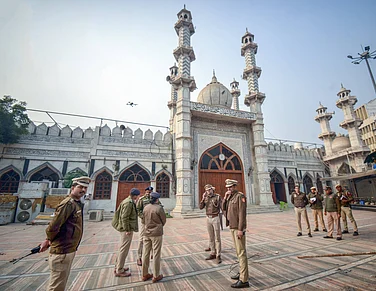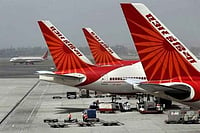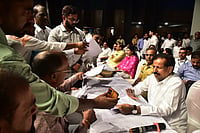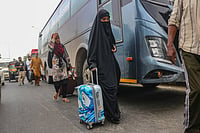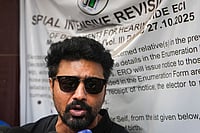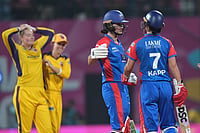On December 6, 1992, when two journalists from the India Today group reached the Babri Masjid atop with kar sewaks, moments before the demolition, they were brutally attacked. The car they were in, in Ayodhya, was burnt while anyone with a camera on the sight was targeted and beaten.
Recalling the incident, one of the journalists Mrityunjoy Kumar Jha , said “While most media ran for their lives, the two Newstrack (India Today’s video section back then) teams hung on and shot everything. We caught on camera photographers and journalists being beaten, and bleeding,” according to a report by Mint.
Jha’s story was not an isolated one as several journalists, from across media houses, admitted to facing a “right-wing frenzy” of this scale for the first time. Over the years, their accounts of how they saw the Masjid being demolished in front of a mob of over a lakh people while risking their lives, hinted at how the Hindu right-wing groups did not want to have any photographic or recorded evidence of the day.
A few days later, India Today came out with the issue: ‘Ayodhya: Nation’s Shame’ -- one that is referred to even today as a piece of powerful reporting. The editor Aroon Purie had then written, “There come moments in history when a nation's soul is seared. For India, that moment came on the afternoon of December 6 when the Babri Masjid-Ram Janmabhoomi-disputed structure, call it what you will, was demolished. It exposed the fragile face of India's secular democracy. The true character of a person is often unveiled in times of crisis…It is a shame because the largest opposition party of the country thought nothing of reducing this country to a mobocracy by encouraging its followers to take the law into their own hands. It knew very well the catastrophic consequences of such an act.”
The demolition, which was largely condemned and criticised by the media, followed headlines from “Kar Sevaks destroy Babri Masjid” to “Unholy War: Assault on the Secular State”, presenting to the world a critical perspective of the tumultuous events in the "holy" land.
In 2017, a report by The Wire described how journalists, who covered the Babri Masjid, were systematically attacked by the Sangh parivar karsevaks so that photos of them razing the masjid to the ground did not become public.
Seema Chishti, one of the journalists who covered the news, said, “There was a clear method in what was going on. The whole idea was to battle the reporters and ensure they do not cover it. This is the biggest change between then and now. If they wanted to pull down a mosque in 2017, beating up reporters may not be necessary. At that time, they needed to do that so that the news does not get out.”
Cut to 2024. Thirty years later, as the Ram Mandir stands on the disputed ground, a stark transformation in the tone of media organisations is evident. Those who once labelled the demolition as the "Nation's Shame" are now seen celebrating the temple's construction, proudly proclaiming "Ram Aayenge."
As the Ram Mandir Prana Pratishta ceremony took place today in Ayodhya amid much fanfare, major news organisations across the nation joined in celebrating the “ShriRamotsav”. Multiple pages of mainstream newspapers such as The Hindustan Times, The Times Of India, Dainik Jagran and Amar Ujala were all about “The Grand Celebration of India” in “Divine Ayodhya”. Pictures of the newly built structure along with pictures of PM Modi and CM Yogi Adityanath filled the pages. TV reporters on the ground and in studios were seen dressed in saffron, garlanded, while news channels changed the theme of their news layouts for the event.
Headlines such as --- ‘Return of Ram’, ‘Ram Mandir for India’, ‘A wait for five centuries’, ‘Wave of devotion across nation’, ‘Significance of chanting matras explained’ --- dominated the prime time news. A collective narrative that suddenly seems to have erased the entire history of the Ayodhya and Babri Masjid demolition.
Further, there has been a surge in advertising rates on news channels leading up to the inauguration of the Ram temple in Ayodhya, reports NewsLaundry. Increased demand for ad slots has been observed, particularly in the special program coverage of the ceremony. Zee Media’s chief revenue officer Mona Jain, as quoted in the report, said “there is substantial growth in advertising rates” and an “overwhelming response”
In the weeks leading up to the event, the Ram Mandir has dominated headlines, gracing the front pages of newspapers and leading bulletins as the primary news package. However, this extensive coverage conspicuously sidesteps any mention of the mosque that once stood at the disputed site. This current narrative sharply contrasts with the media coverage back in 1992.
Another recent report by The Wire argues that mainstream media enabled the emergence of the Ram Temple in significant ways --- how the media began to systematically build up the prime minister as a quasi-spiritual figure by placing cutouts of Modi seen cheek-by-jowl with cut-outs of Lord Ram. In the report, Pamela Philipose, journalist and social researcher writes, “Once the ‘disputed structure’ was reduced to rubble and dust in 1992, it was the temple, not the mosque that gained media coverage,”
Perhaps, is that the truth? Ever since the physical removal of the mosque --- which has shifted the central narrative of Indian electoral politics --- has it also reshaped the media’s focus and framing over time?













